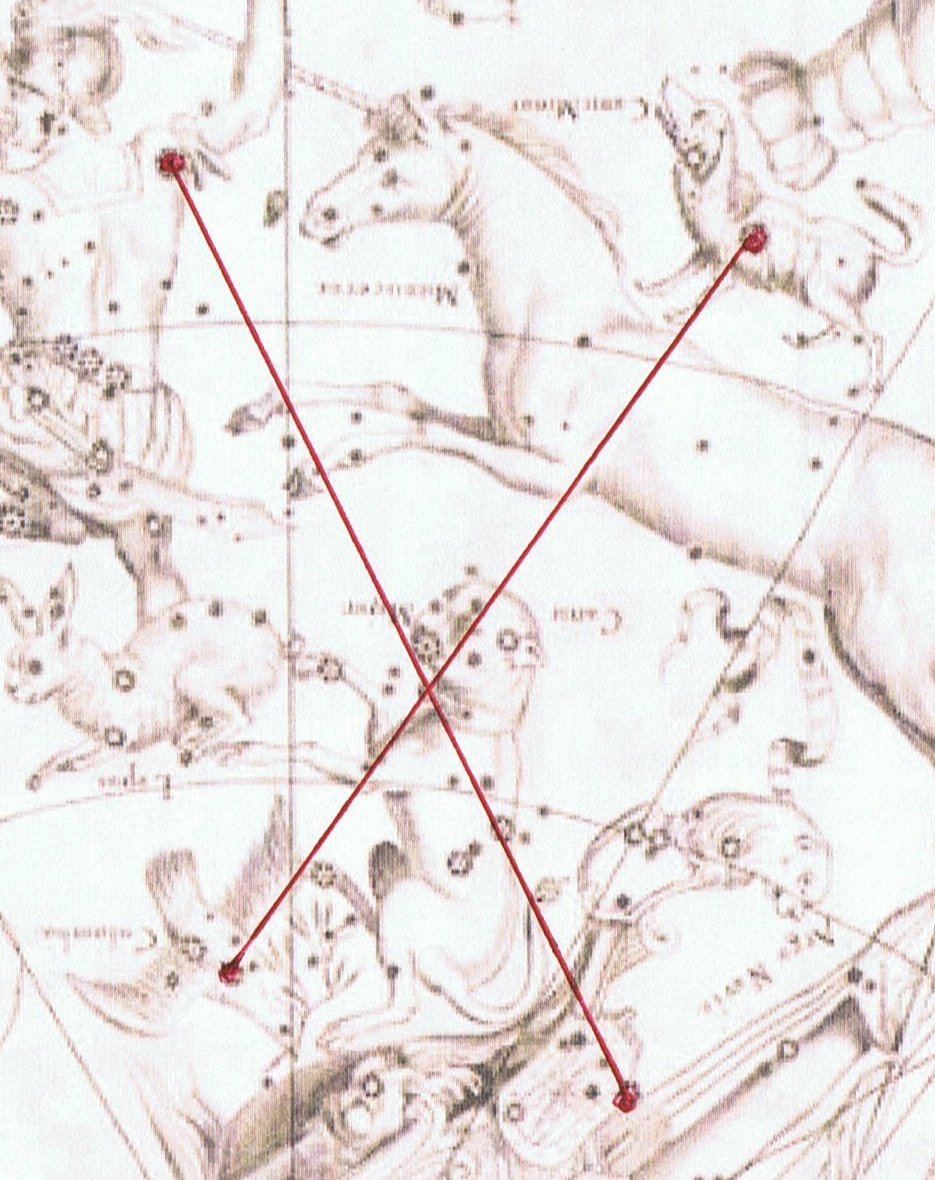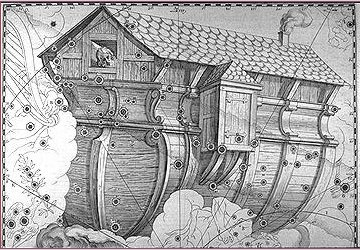There are twin figures late in line Ca4 and early in line Ca5, and perhaps the idea was to draw attention to the pair of halves the year can be divided into. Already anciently the Gemini constellation was created to visualize this concept:  Precession has moved Gemini and the other constellations ahead in the year, and the June solstice is not in the middle of the Gregorian calendar:
But in rongorongo times - and by what appears to be a remarkable coincidence - July 1 happened to be the first day beyond the heliacal rising of Sirius. And July is the 1st month in the 2nd group of 6 months:
The hollow-eyed bird in Gregorian day 180 coincided with right ascension day 100 and also with manzil day 409 (equal to the glyph number at Rogo in Gb6-26). A similar such bird (but with an open beak and a black eye) comes 33 days later in Ca5-28, in August 1. Maybe the text identifies a kind of solstice 'month' as 33 days counted from RA day 100. If number 314 was possible to use every time a circle was to be measured then also other special numbers, such as 33, might have a similar power: "Because the Sun is a spherical (rather than a single-point) source of light, the actual crossing of the Sun over the equator takes approximately 33 hours." (Wikipedia)
The beginning of line Ca5 coincides with the days when Earth is most distant from Sun: "The Earth reaches aphelion currently in early July, approximately 14 days after the June solstice." (Wikipedia) June 21 (172) + 14 = July 5 (186):
We can in Ca5-2 imagine the emergence of a new season of 'earth' (henua), separated (koti) from the previous ('parent') one. And Wezen (δ Canis Majoris) was rising here, in right ascension day 107 (= 472 - 365). Probably the heliacal rising of Castor (the mortal of the Gemini twins) was of importance for the calendar makers, because this event was connected to the day beginning after the night when Antares had culminated:
Furthermore, the midnight culmination of Castor was in February 23, which coincided with the position of the Mensis Intercalaris in the old Roman calendar: ... a 27-day intercalary month, the Mensis Intercalaris, was sometimes inserted between February and March. This intercalary month was formed by inserting 22 days after the first 23 or 24 days of February ... Pollux (the immortal twin) rose in July 15 (= 60 days counted from the beginning of the manzil calendar).
The 4 stars ('stones') of the 'chiastic structure' in Ca5-14 probably together illustrate the great Egyptian X asterism:

The nose of Canis Major (Sirius) should be where the pair of lines are crossing, but this most magnificent of stars is not visible in the design. Phakt rose 30 days before Procyon and Betelgeuze precisely 33 days before Naos. From Betelgeuze the journey appears to go south to the stern (puppis) of the Sunken Ship:  ... In Plato's Timaeus, it is explained that the two bands that form the soul of the world cross each other like the letter Χ ... The figure in Ca5-17 maybe should be read out as Ure Honu ('the penis of the turtle'):
... Ure Honu stayed for a while, (then) he went away and covered the roof of his house in Vai Matā. It was a new house. He took the very large skull, which he had found at the head of the banana plantation, and hung it up in the new house. He tied it up in the framework of the roof (hahanga) and left it hanging there ... The birth of St. John the Baptist was celebrated in June 24. Later came the Sons of Thunder (Boanerges), i.e. the twins St. James and St. John:
The date to celebrate St James (the Great) was July 25 in Western Christianity, April 30 in Eastern Christianity, and December 30 in the Hispanic Church. On the other hand, St John (the apostle) was celebrated in December 27 according to all these church traditions. St George, who died in April 23 in the year 303 AD, was celebrated in April 23. (Source: Wikipedia) Perhaps these saints (in a way still living spirits) inspired the creator of the C text to design a pair of special manu rere - one of them in RA day 33 - quite alike but not exactly so (just like twins):
The tail of tara in April 24 is similar to the pair of 'tail ends' in Rei in July 25. From April 24 to July 25 there are 206 - 114 = 92 days, which could allude to the distance from equinox to the June solstice. Tara in Ca2-8 could correspond to the position after Sun has spent 33 hours crossing the equator. 92 days later we will reach day 33 + 92 = 125 (= 5 * 5 * 5), where the star Bright Fire rose heliacally. We have earlier found number 125 connected with May 25 - where the G text is beginning - and this might possibly cast some light on the pair of twins in early May:
There are 60 days from erua tamaiti in line Ca2 to erua tamaiti in line Ca4. Ca2-16 could have been used to allude to August 4 (216), when the Sirius manzil (Murzim) began:
The manzil calendar is beginning the day after Gregorian day 136 and it could be significant that 136 + 80 = 216.  | |||||||||||||||||||||||||||||||||||||||||||||||||||||||||||||||||||||||||||||||||||||||||||||||||||||||||||||||||||||||||||||||||||||||||||||||||||||||||||||||||||||||||||||||||||||||||||||||||||||||||||||||||||||||||||||||||||||||||||||||||||||||||||||||||||||||||||||||||||||||||||||||||||||||||||||||||||||||||||||||||||||||||||||||||||||||||||||||||||||||||||||||||||||||||||||||||||||||||



















